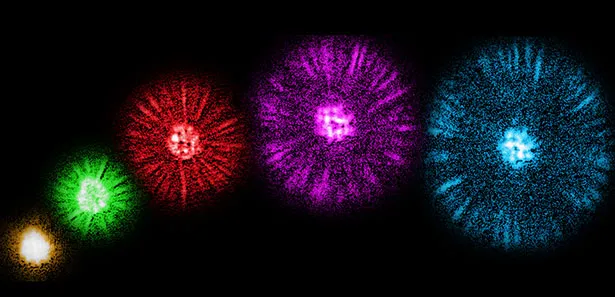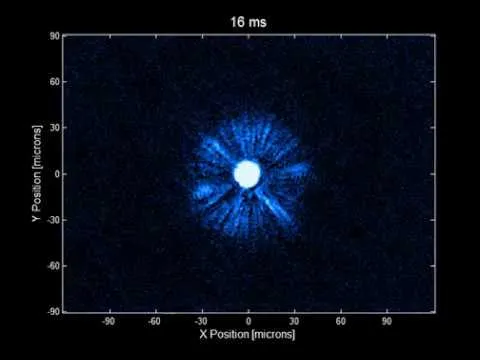Previously unknown behaviour of ultracold atoms surprises researchers

Observed for the first time: The ultracold atoms of a Bose-Einstein condensate emit coordinated particle jets - like fireworks. © Cheng et al.Unexpectedly coordinated: In ultracold atoms in a Bose-Einstein condensate, physicists have discovered a previously completely unknown behavior. When these atoms are collided by magnetic pulses, some are thrown out of the composite. But these do not randomly shoot from the crowd, but form surprisingly coordinated particle fountains, as the researchers report in the journal "Nature". Such a collective issue is completely new.
Cooling down clouds of atoms to just above absolute zero, they go into an exotic matter state: the so-called Bose-Einstein condensate. In this state, the atoms adopt their quantum states and behave like a single "giant" atom. In terms of quantum physics: The individual particles, which can also be described as waves, oscillate in a common mode.
Coordinated particle fountains
In their experiment, Logan Clark and his colleagues from the University of Chicago have literally provoked such a Bose-Einstein condensate out of 30,000 cesium atoms, so to speak: they put the "matched" atomic cloud into a pulsating magnetic field. The alternating field shook the atoms and resulted in collisions within the condensate.
For the first few milliseconds, we did not initially observe any changes, the researchers report. But then suddenly fountains of particles from the composite shot.
The surprising thing about it: These particles were not randomly distributed, but formed coordinated, simultaneous jets.
We see thousands of bosons shooting together in the same direction, explains Clark. It's like people talking and leaving a place in groups.

Collective emission from an ultracold atomic cloud © Cheng et al / University of Chicago
"Completely new fundamental behavior."
As the physicists observed, the particle fountains at a certain excitation threshold leave the condensate in circular halos - similar to the glowing particles in a firecracker.
It's a fundamental behavior that we've never seen before - it was a real surprise for us, says Clark.
This discovery was also unexpected because Bose-Einstein condensates have been intensively researched for years. That, of all things, a completely new phenomenon is observed in this exotic, but supposedly well-known state of matter, astonished even the physicists.
When you discover something so crazy in such a simple experiment, you wonder what else is out there, says Clark's colleague Lei Feng.
Also possible with other quantum systems?
The researchers are already speculating whether these collective emissions could occur in other quantum systems. Because for these particle fountains there might even be technical applications:
If you send an atom in one direction, then in such a system it would be followed by a whole group of other atoms in that direction, explains Clark. That could help, for example, to amplify small signals in the quantum world.
Because these collective particle jets often shoot two fountains in exactly the opposite direction, this newly discovered behavior might also be useful for quantum physical measurements, the researchers said.
Source: Nature, 2017; doi: 10.1038
